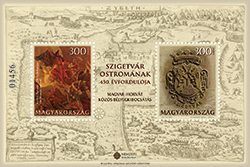
style="display:inline-block;width:728px;height:90px"
data-ad-client="ca-pub-6935274628036882"
data-ad-slot="9409061452">
1. MAGYAR - Szigetvár Ostromának 450. Évfordúlója - Magyar-horvát közös bélyegkiadás - Bélyeg vásárlás >>
2. ENGLISH - 450th Anniversary of the Siege of Szigetvár Joint Hungarian-Croatian stamp issue - Order stamp >>
1. MAGYAR - Szigetvár Ostromának 450. Évfordúlója - Magyar-horvát közös bélyegkiadás
Magyarország és Horvátország közös bélyegkibocsátással állít emléket Szigetvár ostromának 450. évfordulója alkalmából. A két bélyeget tartalmazó blokk Elekes Attila munkája, amit az ANY Biztonsági Nyomda 50.000 példányban nyomtatott ki. A kiadvány szeptember 5-től vásárolható meg a készletek függvényében az elsőnapi postákon és a Filapostán, továbbá a Magyar Posta internetes áruházából is megrendelhető.
A blokk hátteréül egy korabeli Szigetvár ábrázolás, a bélyegeken Székely Bertalan Zrínyi kirohanása című festményének egy részlete, illetve Szigetvár város címere látható. Az első napi borítékon szintén az említett Székely Bertalan festmény részlete tekinthető meg. I. Szulejmán szultán hetedik magyarországi hadjáratára készülve 1566. május 1-jén kelt útra Isztambulból. A 100 ezer főt meghaladó seregével a Dél-Dunántúl kulcsa, a korabeli időszakban korszerűnek számító, különálló szigeteken elterülő Szigetvár bevételére vonult. A várat Zrínyi Miklós dunántúli főkapitány vezetésével mintegy 2300 fős – horvát és magyar végvári vitézekből toborzott – sereg védte. A horvát Šubič nemzetségből származó parancsnok 1542 és 1557 között horvát bánként igyekezett feltartóztatni az ország és a saját birtokai ellen törő hódítókat. Az ostromot 1566. augusztus 6-án megkezdő szultáni seregnek 13 napra volt szüksége az új- és óváros elfoglalásához és a várat övező tó lecsapolásához. Az ekkorra már 800 főre apadt védők a belső várba húzódtak vissza. Szulejmán fenyegetések és ígéretek révén többször próbálta megadásra kényszeríteni Zrínyit – nem kevesebbet ígért neki, mint Horvátország koronáját –, ám a főkapitány a nyomasztó túlerő és Bécs érdektelensége dacára sem nyitotta ki Szigetvár kapuit. A szultán szeptember 7-én meghalt – amit eltitkoltak az ostromló török had elől –, de a romhalmazzá lőtt belső várban pusztító tűzvész megpecsételte a védők sorsát: az ostromlók szeptember 8-án délelőtt hadrendbe álltak a vár kapuja előtt, Zrínyi azonban nem várta meg az újabb rohamot, hanem maradék katonaságával váratlanul kirontott a várból. Zrínyi önfeláldozása a szultán megölése nélkül is komoly jelentőséggel bírt, mert Szigetvár kitartása megmentette Bécset egy újabb ostromtól. A kapitány tettének nagyságát már a kortársak és a későbbi századok politikusai is felismerték, Richelieu francia bíboros és államminiszter például úgy vélte, hogy Zrínyi Miklós és Szigetvár védői 1566 nyarán az egész európai civilizációt mentették meg a pusztulástól. A hős főkapitánynak, a horvát és magyar történelem egyik legnagyszerűbb katonájának emlékét mindkét nemzet tisztelettel ápolja és önfeláldozása mindkét országban számos irodalmi, zenei és képzőművészeti alkotás alapjául szolgált.
Forrás: Posta
style="display:inline-block;width:728px;height:90px"
data-ad-client="ca-pub-6935274628036882"
data-ad-slot="9409061452">
Legyél te is az Bélyeggyűjtők csoport tagja >>
2. ENGLISH - 450th Anniversary of the Siege of Szigetvár Joint Hungarian-Croatian stamp issue
Hungary and Croatia are commemorating the 450th anniversary of the Siege of Szigetvár by issuing a joint stamp. The block containing two stamps is the work of Attila Elekes, fifty thousand copies of which were produced by ANY Security Printing Company.
A depiction of Szigetvár from the period serves as the background of the block, while one of the stamps shows a detail of Bertalan Székely’s painting Charge from the Fortress of Szigetvár and the other the arms of the town of Szigetvár. The first day cover features a detail of the same painting by Bertalan Székely. On 1 May 1566 Suleiman the Magnificent left Istanbul leading his troops on his seventh campaign to Hungary. The army of more than 100,000 men advanced to lay siege to the strategic key to South Transdanubia, the fortress of Szigetvár, which standing on separate islands was considered modern at the time. The fortress was defended by a force of some 2,300 stalwart Croatian and Hungarian soldiers commanded by Miklós Zrínyi. He was descended from the Šubič people, one of the Croatian clans, and, as the Ban of Croatia, endeavoured to contain Ottoman attacks on the country and his own estates between 1542 and 1557. The siege began on 6 August 1566 and it took the Sultan’s army 13 days to capture the old and new towns, and to drain the defensive lake around the fortress. By this time the 800 surviving defenders had withdrawn to the inner castle. Suleiman made threats and promises including the Croatian crown to try and force Zrínyi to surrender on several occasions, but the commander of Szigetvár refused to open the castle’s gates despite being hopelessly outnumbered and Vienna’s indifference. On 7 September the Sultan died and the news of this was withheld from the besiegers, but a destructive fire in the fortress already reduced to rubble sealed the fate of the defenders. In the morning of 8 September the Ottomans deployed their forces in front of the gates but Zrínyi did not wait for another assault and stormed forth with his remaining troops. Zrínyi’s self-sacrifice even without killing the Sultan was very important because Szigetvár’s resistance saved Vienna from another siege. The enormity of the commander’s feat was recognised by his contemporaries and politicians in later centuries, Richelieu, the French cardinal and chief minister, remarking that in the summer of 1566 Miklós Zrínyi and the defenders of Szigetvár had saved the whole of European civilisation from destruction. The memory of the heroic military commander, one of the greatest soldiers in Hungarian and Croatian history, is honoured by both nations, and his self-sacrifice has inspired works of literature, music and the fine arts in the two countries.
Source: Hungary Post



